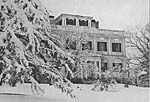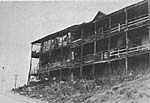

Elin Anderson's ethnic study of Burlington marked a dramatic departure from previous studies of the Eugenics Survey. Professor Perkins had long expected a study of immigrant stocks to reveal "something of eugenical significance" ever since Charles B.Davenport encouraged him to study the French Canadian population as an explanation for Vermont's high rate of draft board rejections. Neither the Vermont Commission on Country Life surveys nor the National Committee of Mental Hygiene study of school children had supported the popular perception that French Canadians were intellectually inferior to the "good old Vermont stock." Yet the racial and ethnic composition of the American population was a key focus of eugenics programs. Professor Perkins assigned Elin Anderson, Assistant Director of the Eugenics Survey, to conduct a specific study the of "immigrant question" in 1932.
 Elin Anderson subordinated Perkins's preoccupation with "racial characteristics"
and external indicators of "good citizenship" to a four year study of the
sociological, economic, and cultural forces that produced the apparent differences
in achievement and status among the major ethnic groups in the city of Burlington:
French Canadians, Irish, Germans, Jews, Italians, and "Old Americans" (the
Yankee Protestants). Beginning with a house-to-house canvas and mapping of
the ethnic composition of Burlington neighborhoods, she expanded the study
into interviews of 450 residents of the city concerning their attitudes towards
community life and relations with other ethnic groups. With the assistance
of women representatives of each ethnic group, she exposed the prejudices
and divisive forces at work in schools, social life, city government, neighborhoods,
and industry and commerce.
Elin Anderson subordinated Perkins's preoccupation with "racial characteristics"
and external indicators of "good citizenship" to a four year study of the
sociological, economic, and cultural forces that produced the apparent differences
in achievement and status among the major ethnic groups in the city of Burlington:
French Canadians, Irish, Germans, Jews, Italians, and "Old Americans" (the
Yankee Protestants). Beginning with a house-to-house canvas and mapping of
the ethnic composition of Burlington neighborhoods, she expanded the study
into interviews of 450 residents of the city concerning their attitudes towards
community life and relations with other ethnic groups. With the assistance
of women representatives of each ethnic group, she exposed the prejudices
and divisive forces at work in schools, social life, city government, neighborhoods,
and industry and commerce.
 Elin Anderson offered an alternative view of the "immigrant question" to
the one popularized in such eugenics treatises as Madison Grant's The Alien
In Our Midst (1930) and the American Eugenics Society Catechism
, which advocated strengthening immigration restiriction of alleged "inferior
races." Instead, she established dialogues among ethnic communities
in Burlington to examine the cultural, social, and economic obstacles to
newer immigrant groups seeking opportunity and acceptance. In a time
of limited resources due to the Depression, labor strikes and communist agitation,
of rising antisemitism and a "dangerous narrowing of the meaning of Americanism"
by patriotic organizations, Anderson exposed the ethnocentrism that produced
social inequities in Burlington and placed "eugenics" within a framework
that later generations of Vermonters would embrace.
Elin Anderson offered an alternative view of the "immigrant question" to
the one popularized in such eugenics treatises as Madison Grant's The Alien
In Our Midst (1930) and the American Eugenics Society Catechism
, which advocated strengthening immigration restiriction of alleged "inferior
races." Instead, she established dialogues among ethnic communities
in Burlington to examine the cultural, social, and economic obstacles to
newer immigrant groups seeking opportunity and acceptance. In a time
of limited resources due to the Depression, labor strikes and communist agitation,
of rising antisemitism and a "dangerous narrowing of the meaning of Americanism"
by patriotic organizations, Anderson exposed the ethnocentrism that produced
social inequities in Burlington and placed "eugenics" within a framework
that later generations of Vermonters would embrace.
In 1937, Harvard University Press published her study as We Americans: A Study of Cleavage in An American City, which received the John Anisfield Award for the best book of the year that promoted inter-racial understanding. Anderson's extraordinary study endures as an important statement of the value of cultural diversity and an indictment of the social forces that work to suppress it. Most important, We Americans testifies to one woman's courage and willingness to challenge the prejudice within her own organization and undermine the assumptions of its previous projects:
The significance of We Americans lies in its purely local focus set against the larger national and international turmoil of the years leading up to World War II. While Anderson captured the sentiments and realities of life in Burlington in the 1930s, her insights speak to the enduring issues of cultural diversity, equity and opportunity, and community integrity. Anderson's notes from her preliminary interviews of 1932-33 bring to life the voices of the past and reveal with startling clarity a cross-cultural view of the social and political landscape in which she lived and worked for seven years.